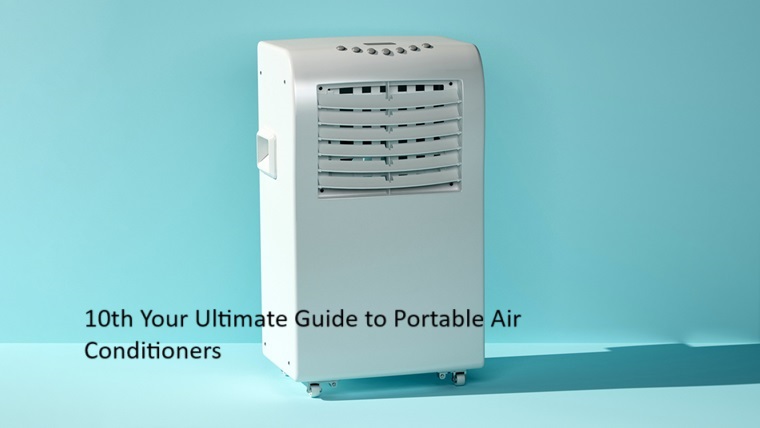Navigated Table of Contents
Beat the Heat Anywhere: Your Ultimate Guide to Portable Air Conditioners – The summer sun is blazing, and while you dream of escaping to a tropical paradise, the reality is your apartment feels more like a furnace. But before you resign yourself to another sweaty season, consider the versatile solution of portable air conditioners.
These handy units offer a refreshing escape from the heat, without the hassle of permanent installation or the limitations of window units.
Types of Portable Air Conditioners:
Portable air conditioners come in various types, each with its own set of features and benefits. Here’s a breakdown of the most common types:
- Single-Hose Models: These are the most common and affordable type of portable air conditioner. They use a single hose to draw in warm air and expel cool air, but they tend to be less efficient than dual-hose models.
- Dual-Hose Models: These models use two hoses, one for drawing in warm air and another for expelling cool air. This design allows for more efficient cooling and better temperature control.
- Evaporative Coolers: These units cool the air by using water evaporation. They are ideal for dry climates and don’t require venting, but they are less effective at cooling large spaces.
- Air-to-Air Heat Pumps: These models work like traditional heat pumps, using a compressor to transfer heat from the air inside to the air outside. They are highly efficient but tend to be more expensive than other types of portable air conditioners.
Cooling Capacity and BTU:

The cooling capacity of a portable air conditioner is measured in British Thermal Units (BTU). The higher the BTU rating, the more powerful the unit and the larger the space it can cool. For smaller rooms like bedrooms or offices, a unit with 7,000-10,000 BTU is usually sufficient. For larger spaces, you might need a more powerful unit with a higher BTU rating.
READ; Portable Air Conditioner with Heat: 8 Facts Explained
Choosing the Right BTU Rating:
Selecting the correct BTU rating is crucial for ensuring optimal cooling performance. Here’s a general guideline to help you choose the right unit for your space:
- Small rooms (up to 150 sq ft): A portable air conditioner with a BTU rating of 7,000-10,000 BTU is typically sufficient. Examples of such spaces include bedrooms, small offices, and dorm rooms.
- Medium-sized rooms (150-300 sq ft): For these spaces, a unit with a BTU rating of 10,000-14,000 BTU is recommended. Examples include living rooms, dining rooms, and larger bedrooms.
- Large rooms (300-500 sq ft): For larger spaces like open-plan living areas or studios, a unit with a BTU rating of 14,000-20,000 BTU is necessary.
- Extra-large rooms (over 500 sq ft): For expansive spaces or rooms with high ceilings, a powerful unit with a BTU rating exceeding 20,000 BTU is required.
Factors Affecting Cooling Needs:
It’s important to note that several factors can influence your cooling needs, even within the same room size. These factors include:
READ; Beat the Heat Anywhere: 10th Guide to Portable Air Conditioners
- Climate: In hotter climates, a higher BTU rating is necessary to compensate for the intense heat.
- Number of windows and doors: Rooms with more windows and doors tend to lose cool air more quickly, requiring a more powerful unit.
- Insulation: Well-insulated rooms retain cool air better, allowing for a lower BTU rating.
- Number of occupants: More people generate more heat, requiring a higher BTU rating.
- Sun exposure: Rooms that receive direct sunlight tend to be hotter, necessitating a more powerful unit.
Beyond BTU: Additional Considerations:
While BTU rating is a crucial factor, it’s not the only consideration when choosing a portable air conditioner. Other factors to keep in mind include:
- Energy efficiency: Look for models with a high Energy Efficiency Ratio (EER) rating to minimize energy consumption and reduce your electricity bills.
- Noise level: Consider the noise level of the unit, especially if you plan to use it in a bedroom or other quiet space.
- Additional features: Some models offer features like dehumidification, air purification, and remote control, which can enhance your comfort and convenience.
Remember: Choosing the right portable air conditioner with the appropriate BTU rating and considering other essential factors will ensure optimal cooling performance and a comfortable environment during the hot summer months.
Installation and Setup:
One of the biggest advantages of portable air conditioners is their ease of installation. Unlike window units, which require drilling holes and permanent installation, portable air conditioners simply need to be plugged in and vented.
Most models come with a window kit that allows you to attach the exhaust hose to a window. However, some models offer ventless options, which are ideal for spaces with limited window access.
Energy Efficiency and Power Consumption:
Portable air conditioners can vary in terms of energy efficiency. Look for models with a high Energy Efficiency Ratio (EER) rating, which indicates how much cooling you get for each unit of energy consumed. Additionally, features like timers and sleep modes can help you save energy by automatically turning the unit off when you’re not using it.
Maintenance and Care:
To ensure optimal performance and longevity, regular maintenance is essential. Clean the air filter regularly, usually every two weeks, to prevent dust buildup. Additionally, clean the condenser coils and evaporator coils periodically to maintain efficient heat exchange.
Additional Features and Functions:
Modern portable air conditioners offer a variety of additional features and functions to enhance your comfort and convenience. Some models come with dehumidification capabilities, removing excess moisture from the air. Others offer air purification features, capturing dust, pollen, and other airborne particles. Additionally, features like remote control, programmable timers, and multiple fan speeds provide greater control and flexibility.
Conclusion:
Portable air conditioners are a versatile and convenient solution for beating the heat. Whether you’re a renter, live in a space with limited window access, or simply want the freedom to move your cooling unit around, these units offer a refreshing escape from the summer heat. By carefully considering the factors discussed in this guide, you can choose the perfect portable air conditioner that meets your specific needs and preferences, ensuring a cool and comfortable summer experience.




